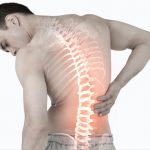
I Hurt My Back: What Should I Do?
If you have recently injured your back you will know how painful and crippling it can be. Here we share our tips for what to do when you injure your back to help you recover as quickly as possible.
As the back supports so much of the weight of the body, there are many different ways we can cause injury to our back. Anything from high (or low) impact exercise, lifting, pulling, sitting or even sleeping badly can cause a back injury. The back is largely responsible for our posture, balance and movement, so injuring this part of the body can feel completely debilitating.
There are a number of things you can do in the event that you hurt your back to minimize further damage and hopefully increase healing time. This initial stage can be crucial in determining how bad the injury is and whether it can fully recover without causing you problems down the track.
First Step: Stop & Rest
In our busy and demanding world, proper rest can be something that people find extremely hard to do. However, proper rest for the first 72 hours after injury can be the difference between a speedy recovery and a long, drawn-out one!
When you have injured your back, the first thing to do is to stop doing what caused the injury. Whether you are at the gym, moving a couch or lifting something you must stop immediately as soon as you feel you have caused some damage. Continuing to perform the same action will further aggravate the injury and cause more damage as the body tries to overcompensate for the injured area.
Medicate as Needed
Commonly, patients are hindered by the fact that laying down and resting causes them pain and discomfort especially with lower back pain. While it can be tricky initially, simple medication such as paracetamol as well as some muscle relaxants can help your body and the injury get much-needed rest. Non-steroidal anti-inflammatory drugs can alleviate pain, inflammation and swelling around the problem area.
Extended use of medication should be carefully monitored by your healthcare professional and if the pain turns chronic, other treatment options (below) should be looked at.
Topical ointments such as Deep Heat or natural essential oils can also help to provide pain relief while also increasing blood flow to the area.
Ice or Heat
A combination of the two is actually the most beneficial.
Generally, it is recommended that only ice is applied in the first 48-72 hours, and then heat after that.
Ice can help to reduce inflammation, which is highly beneficial in the early stages so that you can move on to other treatment options.
Heat increases circulation and blood flow, helping with pain but will also relieve tension in the muscles.
Seek Professional Treatment
It is generally best to wait until the inflammation has gone down before seeking the help of a massage therapist, physiotherapist or other therapist of your choosing. Once the inflammation is down, they will be able to ascertain the root cause of the injury. Sometimes the injury may not be where you think as the more intense pain can be referral pain.
A professional at this point will be able to help alleviate the strain and tension on the muscles in and around the injury point. This can provide incredible relief and can fully heal injuries at this point. On-going treatment may be required depending on the severity of the injury however persistence can prove worthy if the injury goes away for good!
Gentle Exercise & Movement
Gentle non-impact exercise like gentle swimming, walking, cycling and especially Pilates can be extremely beneficial in strengthening the area around the injury. This supports the injury to heal quicker and ensures blood is moving, and the body is functioning properly.
Its best to work with a professional who can advise as to the types of exercises and movements that are best suited to the injury and your body.
At all times, it is best to avoid anything strenuous that would put unnecessary pressure on the injured area or on the body as a whole.
Still in Pain?
If you are still experiencing significant pain with no relief there may be something more severe at play. Read our article ‘Chronic Back Pain: Diagnosis & Treatment‘ for more information and suggested next steps in your healing process.






